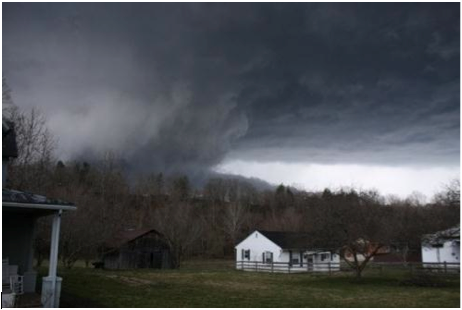
March 2, 2012 West Liberty, Kentucky tornado courtesy of Kent Nickell=
Tuesday's 13 large, violent tornadoes in the Dallas were a wake-up call for America. With camera-ready smartphones -- it may have been the most-photographed and filmed tornado outbreak in history -- dramatic video that convinced many locals to take the warnings seriously and take cover. Had the Arlington tornado tracked just 19 miles farther east it would have struck downtown Dallas.
A convergence of meteorological and socioeconomic trends has left America more vulnerable to a catastrophic tornado; a single long-lasting tornado hitting a major urban center -- potentially putting thousands of lives at risk. It's too early to know if it's an aberration or a trend -- but in recent years some of the largest, most destructive tornadoes have struck east of the Mississippi River, hitting more densely populated cities and suburbs. There's no clear-cut evidence we're seeing more violent tornadoes, but "Tornado Alley" appears to be expanding north and east. People in Dallas know what to do. Baltimore? Not so much.
2011 brought six EF-5 tornadoes, as big and violent as they get. The movie "Twister" described an F5 as "the finger of God." They are beyond words. Dazed tornado survivors from Joplin to Tuscaloosa are still picking up the pieces of their lives. Their trauma has lessons for the rest of us. Tornadoes bulldozing the eastern U.S. present a unique problem. They're much harder to track (more hills and haze; highways that make chasing tornadoes all but impossible). Many homeowners don't have safe, underground options. Bedrock and high water tables can make it prohibitively expensive to excavate for a basement; the only thing that makes a 200 mph EF-5 super-tornado survivable.
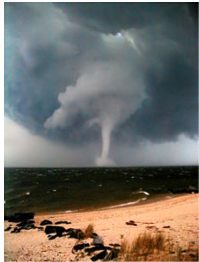
April 28, 2002 La Plata tornado
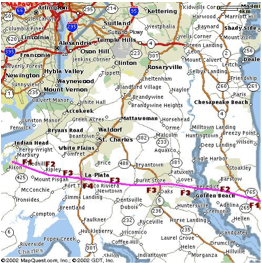
Track of F4 La Plate tornado
What would happen if a major, long-lasting and violent tornado tracked across the close-in suburbs of Chicago, Detroit, Memphis, or even Washington D.C.? Don't laugh. On April 28, 2002 an F4 tornado tracked a little more than 30 miles south of the White House, leaving behind a trail of significant damage in La Plata, Maryland.
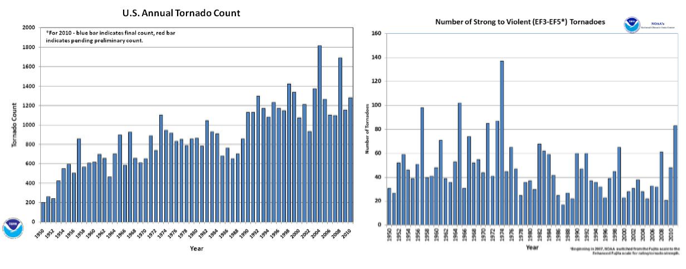
Tornado count since 1950. Doppler radar has increased detection of smaller EF-0 and EF-1 twisters. SPC No apparent increase in violent tornadoes since 1950. NCDC.
Tornado Fatigue. "But Paul -- Doppler will save us!" Maybe. Doppler radar can pinpoint spinning "supercells" most likely to spawn a tornado. It works best on the big tornadoes. Even today there's still no way to tell -- with consistent accuracy -- whether a spinning storm will go on to spark a minimal EF-0 twister (60-70 mph winds, capable of light damage), or a mile-wide "wedge", an EF-5 super-tornado. The National Weather Service does a remarkable job, but their mandate is to spot and warn for every tornado. Err on the side of safety, right? But 70-85% of rotating storms and subsequent tornado warnings wind up being false alarms, interrupting TV shows, irritating Americans watching "The Voice" and "60 Minutes." Viewers glaze over and tune out. "You chop up my favorite show with your warnings -- but we never see anything at our house. You're crying wolf!" I get it. The truth? We're not as good as we think we are.
"One of these days we're going to have 1,000 or more deaths from a single tornado somewhere in the United States," said meteorologist and Haag structural engineer Tim Marshall, at a recent Severe Storm and Doppler conference in Des Moines. I couldn't believe my ears. Marshall is a legend in the tornado research community; he has studied hundreds of outbreaks, looking for ways to make structures more tornado-resistant. "With the exception of Hurricane Alley most U.S. homes are built to withstand only 90 mph wind gusts" he continued. A violent tornado can spark 120-200 mph winds for 1-3 minutes. "CMU, concrete masonry unit construction (hollow cinder blocks), fails quickly during a tornado" Marshall explained. Most homes away from the coast are simply not designed to withstand a moderate or severe tornado. Mobile homes are far more vulnerable -- some can flip in a light 70 mph breeze. The tornadoes that roared through Joplin and Tuscaloosa last year were rare EF-4 and EF-5's, up to a mile wide, with sustained winds approaching 200 mph. No cost-effective construction can withstand that kind of a sudden thrashing.
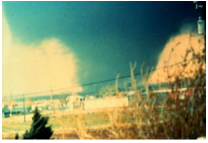
1979 Wichita Falls F-4 tornado, courtesy NOAA
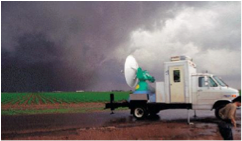
"DOW" -- Center for Severe Weather Research
"A Nation of Sitting Ducks." During the 1979 Wichita Falls F4 Texas tornado 58 people died; many killed in their vehicles, stranded in traffic, trying to get home to their families before the twister arrived. The tornado that struck Moore, Oklahoma on May 3, 1999 spawned the highest wind speeds ever measured on the face of the Earth. A portable "DOW", Doppler on Wheels, registered sustained winds of 301 mph. It forced other cities to simulate what a similar mega-tornado might do if it landed in their metro area.

Computer simulations courtesy of The North Central Texas Council of Governments.
Tuesday's major outbreak in the Dallas metro made my heart skip a few beats. 2002 simulations of a worst-case 200 mph EF-5 tornado striking Dallas at rush hour estimated that as many as 87,000 motorists could be trapped in traffic gridlock -- thousands could be killed, tens of thousands maimed; many in their cars, with nowhere to go. Like something out of a horror flick. Imagine thousands of families at Six Flags, 35,000 cheering fans at Comisky Park on the south side of Chicago; thousands of shoppers huddled at the Mall of America near Minneapolis. Could thousands be evacuated to shelters in time, in minutes or even seconds? Would people even take the warning seriously? There's still a dangerous mind-set that "tornadoes can't hit metro areas... they can't cross rivers, lakes and hills". Not true. Warmer, drier metro areas may inhibit the smallest tornado from forming, but a violent, long-lasting; long-track EF-4 tornado is like the proverbial bear in the woods: it goes where it wants to go.
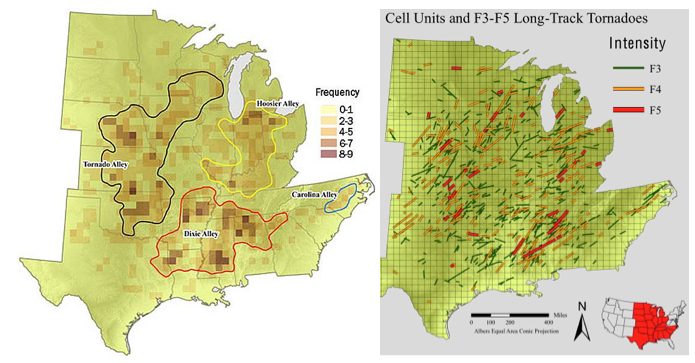
Maps above courtesy of Michael Frates, University of Akron. More information here.
Is Tornado Alley Shifting East? A potentially worrying trend on the weather maps: an (apparent) eastward shift in "Tornado Alley". The most tornadoes in 2010? Minnesota. 2011? Alabama. Now camera-toting tornado chasers are spending more time in "Dixie Alley", which runs from Louisiana to Little Rock, Nashville and Huntsville. In recent years the biggest, deadliest tornadoes have touched down east of the Mississippi. Large, violent eastern tornadoes don't even look like classic funnels -- twisters are often "rain-wrapped" -- they can be easily mistaken for rain shafts, making it harder for people in the path to take them seriously. These fat, writhing, almost unrecognizable "wedge tornadoes" are grinding into more heavily-populated areas. When a tornado does touch down -- there's a higher probability it will hit neighborhoods, not farmland.
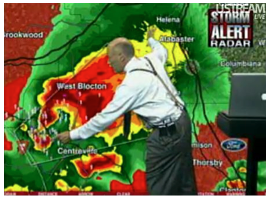
"Tornado Fatigue" and a "Siren Mentality." Alabama meteorologist and storm-tracking legend James Spann isn't alone in worrying about too many tornado warnings issued for brief, tiny EF-0 tornadoes. "Most warnings are false alarms. There are too many warnings for minor tornadoes -- which winds up annoying viewers trying to watch "Dancing with the Stars". When a monster tornado does spin up viewers are apathetic. They don't take it seriously" he said to an audience of 200 meteorologists. Another problem: the sirens. They were never meant to be heard indoors; yet too many people still rely on them. "We have a siren mentality. It's antiquated WW1 air raid technology!" His other concern: a lack of personal responsibility. "Local officials will save me!" No they won't. "You're responsible for your own personal safety, and the ultimate safety of your family." Technology can help to underscore the gravity of a specific tornado threat.
Spann probably uses social media better than any TV meteorologist in America. He relies on a network of tweets, webcams and live streams from chasers, so he can point to a screen and say "HERE is the tornado. This is not a false alarm. Take cover NOW!" Spann still occasionally chokes up talking about last year's historic outbreak. It affected him deeply, and thousands of people from Alabama to Ohio are walking wounded, some injured, many unable to focus or sleep, exhibiting PTSD (post-traumatic stress disorder) symptoms usually reserved for returning war veterans. His meticulous attention to detail probably saved hundreds of lives during last April's Alabama tornado swarm, now thought to be the biggest in U.S. history.
A staggering 208 tornadoes touched down on April 27, 2011, 16 in one Alabama county alone -- a staggering 358 tornadoes between April 25-28. In spite of Doppler and TV stations going "wall to wall." Why did 346 people die? Many were trapped in mobile homes, others relied on the sirens -- some never got the word, others ignored the warnings.
"Confirmation Bias." A source of growing sense of unease among meteorologists: recent research suggests that many Americans, especially people living outside traditional Tornado Alley, don't do the right thing (run for shelter) until they see the tornado with their own eyes, or get confirmation from multiple sources that a tornado threat is real -- on the ground, and moving toward their home. Maybe it's human nature to be skeptical. But any hesitation increases the odds of becoming a tornado statistic.
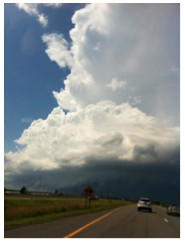
"Supercell" T-storm
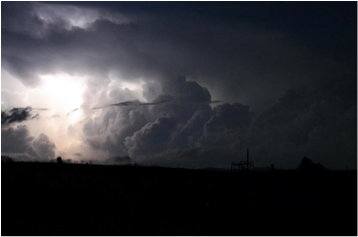
Image courtesy of CAVU Photography, Abilene, Texas
Tornado Tip-offs. Odds are you'll never encounter a monster-tornado. There are tell-tale signs that often precede a major outbreak. Yes, some of those "old husband's tales" are true:
1). "A Tornado Sky". An eerie green/yellow sky often (but not always) precedes a tornado thunderstorm. This is the result of white sunlight being scattered (filtered) by big hailstones suspended aloft. When the sky turns an evil shade of green trust your gut. Head to safety.

In 2010 Minnesota saw more tornadoes than any other state (145). These tornado shots taken near Albert Lea, Minnesota on June 17, 2010 -- courtesy of WeatherNation TV meteorologist Aaron Shaffer
2). Wall Clouds. Large tornadoes don't tumble out of a blue sky. You need a (mutating) thunderstorm, one that's spinning violently. A typical tornadic storm produces rain, then hail. A spinning, lowering cloud base at the rear flank of a storm is called a "wall cloud", the focus of violently-rising air. It's here a tornado is most likely to spin up.
3). Large Hail. The larger the hail, the stronger the updraft necessary to keep those icy stones suspended in midair. I get nervous when hail is larger than golf balls. Baseball-size or larger? The odds of a large tornado nearby are high. Use hailstone size to gauge the severity of a thunderstorm updraft.
4). Isolated "Supercell". It's rare to get (large/violent) tornadoes in a squall line, a solid line of severe storms. The most dangerous "cells" are isolated, often forming 20-75 miles ahead of the main band of thunderstorms. These are the ones you need to keep an eye on.
5). Warm Front/Dry Line. The wind environment surrounding a warm front is most favorable for tornadoes, with ample "wind shear" (changing wind speed/direction with altitude) to start storms spinning. When dew points top 60 F. there's enough "juice" in the air to spawn severe storms; it's time to be on alert. Severe storms often flare up along the leading edge of dry, desert air, the "dry line".

Track tornadoes like a pro. Tapping the power of GR2 Analyst, a $250 PC program, you can dial up any NWS Doppler radar, visualizing storms in 2-D and 3-D, looking for tornadic circulations. Images from Tuesday's outbreak near Lancaster, Texas.
Lower the Risk: "Multiple Safety Nets"
The good news: there have never been more ways to receive a potentially life-saving tornado warning within seconds of being issued by your local National Weather Service. Make it a goal to have multiple safety nets. Never rely on just one source. Every family should take advantage of:
1). NOAA Weather Radio. Your TV won't wake you up at night, when many tornadoes arrive (especially east of the Mississippi). A $20-50 NOAA Weather Radio is the only device that will send out a loud, audible shriek if a tornado is moving into your county, even if the power goes out. It's the best, cheapest form of life insurance you'll ever own. Have one at home, the office and every school & nursing home.
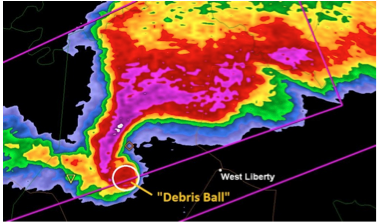
2). Local Media. Across most of Tornado Alley and Dixie Alley professional TV meteorologists will interrupt regular programming when there's a significant tornado threat. Annoying? Yes. I was always amazed when tracking tornadoes on the ground. "Why are you interrupting Oprah?" Yes ma'am, but what if it was your county? Cut your local TV meteorologist a little slack. They're doing the best they can; many stations have live Doppler. Typical NWS "NEXRAD" Doppler has a 4-5 minute delay between each "volume scan", each 3-D scan of the atmosphere within 75 miles of the radar site. Live radar gives you a real-time view of what's happening near ground level. The entire network of NOAA Dopplers is being upgraded to "dual polarization" capabilities, which may allow meteorologists to see the actual "debris ball" (the pieces of wood, dirt, buildings, cars etc.) being kicked up into the air by a tornado on the ground. This breakthrough, over time, should lead to fewer false alarms. That's the hope.
3). Internet. The SPC FAQ page has good information. It's not a bad idea to start every day by clicking over to NOAA's Storm Prediction Center, SPC. At a glance you can see if there's a slight, moderate or high threat of tornadoes. A "Slight Risk" means a small chance of small, brief tornadoes. A "Moderate Risk" is my personal trip-wire: it means a much better chance of large, violent twisters. On those rare 2-3 days a year a "High Risk" is issued, batten down the hatches. A major outbreak is imminent. One of my companies, Ham Weather, has a (free) link showing storm reports, with 5-minute updates. Now you can see, in close to real time, which storms are actually producing damage on the ground.
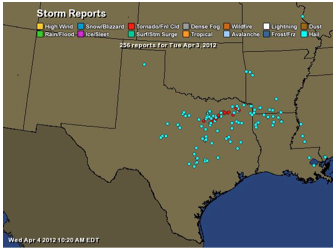
Tuesday storm reports from Ham Weather
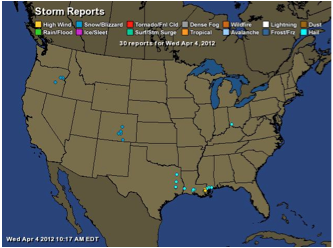
USA storm reports so far today (as of 10 am)
4). E-Mail Alerts. Several sites allow you to receive (free) severe storm e-mails when a warning is issued. Again, the more sources of information, the greater the odds you'll get the word in time.

5). Smartphone Apps. This is the future: warning people in the immediate path of tornadoes, the "polygon" issued by each local NWS office -- the "high-threat area". With location services turned on, your phone knows where you are, allowing you to be alerted the instant a warning is issued for your GPS location. Favorite apps include RadarScope, iMapWeather Radio, My-Cast Weather Radar and PYKL3 (Android). You may pay a few bucks, but its ultimate peace of mind. And no, I don't get a commission.
6). Sirens. I placed sirens at the bottom of my list for a reason. The Emergency Outdoor Sirens were designed for outdoor use only. They were never meant to be heard inside your home. Yet millions of Americans rely on the sirens as a cue to take cover. This is a recipe for disaster.
Take Control: Draft a "Tornado Action Plan". Sit down with your kids and talk about severe storms. Just like a mock fire drill; explain what to do and where to go if a tornado warning is issued. Leave nothing to chance. If you talk calmly there's no reason for anyone to get upset. Have the chat -- soon. So where is the safest place?
· Home. Basement, under the stairs, under heavy furniture, like a table or workbench.
· No basement? Find a small, windowless room on the ground floor, like a closet or bathroom. People have survived tornadoes huddling in their bath tubs. No kidding.
· Office: avoid outer walls, windows. Seek shelter in a concrete stairwell or interior bathrooms. How many people can you stuff into one bathroom stall?
· School: we have nightmares about tornadoes hitting during class. Hallways aren't always the safest place to ride out a tornado. Avoid windows, and large rooms, like auditoriums and gymnasiums. More tips for school administrators from NOAA here.
· Mobile Home Parks. How is it possible we don't have laws mandating tornado shelters in every mobile home residence in America? My personal opinion: I think its borderline criminal this hasn't happened yet. I'm waiting for someone in Congress to step up and surprise us all by doing the right thing, and enacting legislation to make this a LAW.
What I'm about to suggest is still controversial and not sanctioned by the National Weather Service or local law enforcement. If you live in a trailer park and you have confirmation a large tornado is bearing down -- don't ride it out in a mobile home. If there is time, and no underground shelter or basement nearby, get into your vehicle and drive away from the tornado at right angles. Your odds of survival may be slightly higher in a vehicle, a nearby store (freezer?) -- even a ditch -- than taking a direct hit from a large tornado in a prefabricated home.
Tornado Helmets? No, it's not getting sucked into the clouds like Dorothy in The Wizard of Oz. Nearly 90% of tornado deaths and injuries result from blunt head trauma. That's why you want to get below grade, in a basement, if possible, to avoid a violent blender of hurtling debris. Here's a hint: Find bike/football/hockey helmets for yourself and your kids. I know it sounds a little crazy, but anecdotal evidence suggests padded helmets can greatly lower the risk of blunt head trauma. It may look a little goofy, but then again, looking goofy may just save your life.
"Situational Awareness". Think twice before going to the mall or a ball game when a Tornado Watch is in effect. If you do -- check Doppler (on your phone) and be alert for storm warning e-mails or texts. Ask yourself: where would I go if a tornado approached...here and now? If you're under a PDS (Particularly Dangerous Situation) Tornado Watch, you should be even more vigilant. A tornado is an "atmospheric hiccup". There's still no way to predict precisely where and when one will touch down -- all we can do is tell when conditions are ripe, and a Tornado Watch is issued, usually for 3-8 hours into the future. If a rotating T-storm shows up on Doppler, or professional SKYWARN storm spotters, chasers or law enforcement spot a developing tornado, your local NWS office will upgrade the Watch to a Tornado Warning. Don't grab your video camera -- head straight for the basement. Don't tempt fate.
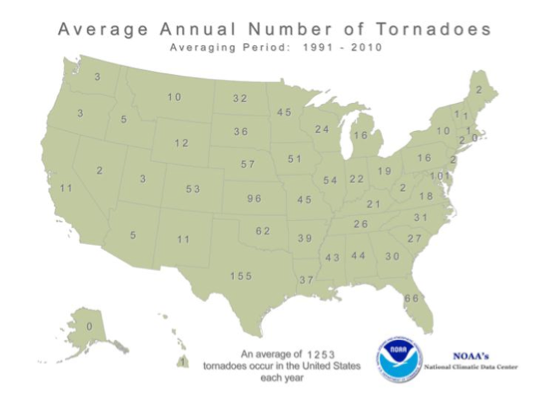
Average tornadoes/year: 1991-2010. Source: NOAA NCDC
There's still no conclusive evidence that (large/violent) tornadoes are on the increase, in spite of a warmer, wetter atmosphere. More research is needed before we know, definitively, if an apparent eastward shift in the most violent twisters is a fluke, or a trend. Almost any tornado is survivable, if you take the warnings seriously and prepare your family for a worst-case scenario. Don't wait for local officials to save you. Ignore the sirens -- odds are you won't even hear them when you need them most. The good news: with a little planning you can rely on apps, TV, radio, texts, e-mail alerts, the Internet and NOAA Weather Radio to get a potentially life-saving nugget of information in time to take action and protect your loved ones.
In spite of Doppler radar, and skilled (sometimes pleading) TV meteorologists providing continuous coverage tornadoes 2011 claimed 550 American lives. It was a national tragedy. It was the worst year for tornado fatalities since 1925, and the years ahead may be even more violent.

USA tornadoes reported in 2011
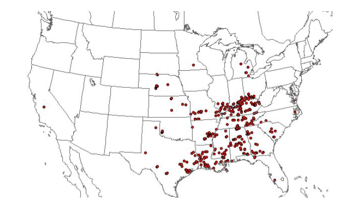
Tornado touchdowns so far in 2012 from SPC
We live in the Super Bowl of Weather. America experiences more tornadoes than any nation on Earth. Why? The same geographic features that make our nation so beautiful spawn a witch's brew of airmasses, which often collide. Moist air from the bayous of Louisiana near the ground mixes with dry desert air from Tucson aloft; shifting winds with altitude giving thunderstorms a spin, resulting in hail, and in 1 out of 100 storms, a tornado. Urban sprawl and a possible eastward shift in where these fickle, violent storms touch down are increasing the potential for a disaster unlike anything this country has experienced. An EF-4 or EF-5 tornado hitting a major metropolitan area could dwarf the damage and loss of life from Hurricane Katrina in 2005, killing thousands; maiming tens of thousands with chronic, lifelong injuries, sparking a $ 5-15 billion trail of rubble. Tornado intensity trends since 1950 below:
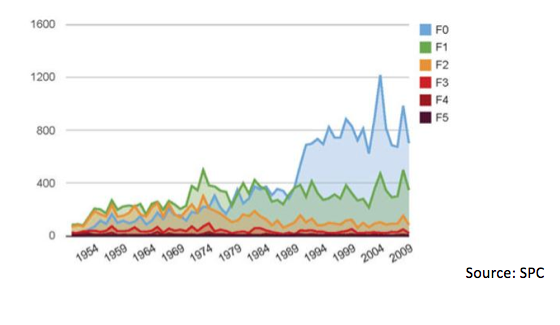
The Weather Underground's Dr. Jeff Masters speculates the last two years may have been the most severe in America's history, dating back to 1816. Something has changed. It may be a temporary aberration, but an apparent eastward shift in Tornado Alley may threaten millions of Americans who still believe a tornado is something only experienced in Kansas. But Chicago, Nashville, Atlanta and Washington D.C.? It can't happen there, right? Wrong. The trends are troubling, but if you keep your situational awareness, have multiple safety nets, take advantage of new tornado warning technology, don't depend on the sirens, draft a Tornado Action Plan with your family -- and take every single tornado warning seriously, you'll breathe a little easier the next time angry thunderstorms rumble overhead.